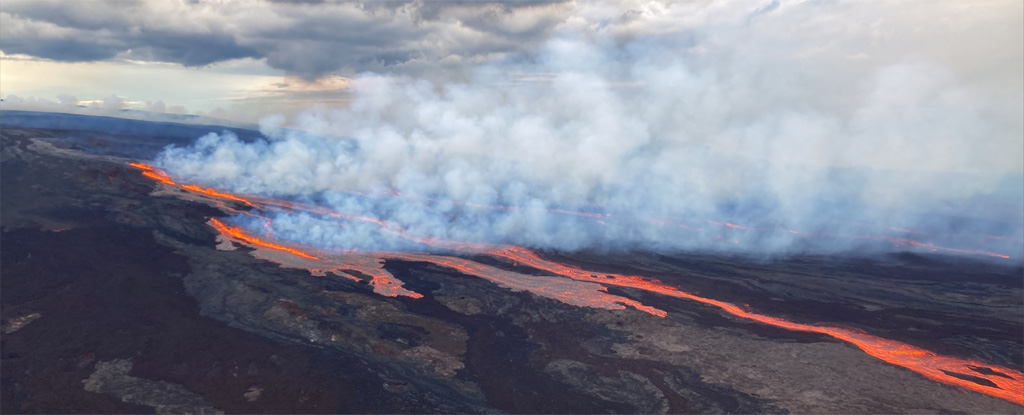Products You May Like
For the first time in decades, Hawaii’s Mauna Loa – the largest active volcano in the world – erupted, turning the sky red.
The eruption began around 11:30 pm local time Sunday night (0930 UTC Monday morning) in Mauna Loa’s summit caldera, according to a United States Geological Survey statement.
In a 7:20 am local time update Monday, the agency said lava was flowing out of the northeast side of the volcano, known as the Northeast Rift Zone.
“Lava flows are not threatening any downslope communities and all indications are that the eruption will remain in the Northeast Rift Zone,” the USGS said. It added that winds could carry volcanic ash, gas, and glass elsewhere.
The agency’s volcanic ash advisory prompted Southwest airlines to cancel 10 flights between Hilo and Honolulu on Monday.
“At the moment, we don’t expect any other impacts,” a spokesperson for the airline told Insider.
“Based on past events, the early stages of a Mauna Loa eruption can be very dynamic and the location and advance of lava flows can change rapidly,” the USGS said.
“If the eruption remains in Moku’āweoweo [the summit caldera], lava flows will most likely be confined within the caldera walls. However, if the eruptive vents migrate outside its walls, lava flows may move rapidly downslope.”
Satellite view from GOES West shows the development of the Mauna Loa eruption and associated plume (Island of Hawaiʻi is in lower left). From https://t.co/oOmUBmf990. Lava remains confined to the summit caldera at this time (1AM HST). pic.twitter.com/5ohKCNoIsL
— USGS Volcanoes🌋 (@USGSVolcanoes) November 28, 2022
Hawaii’s Emergency Management Agency and Hawaii’s Tourism Authority both said Monday morning that there was no immediate threat to populated areas.
Officials have not issued evacuation orders but Hawaii County opened several shelters, reports Hawaii News Now.
The National Weather Service’s Honolulu branch issued an ashfall advisory, warning that up to a quarter inch of ash could accumulate on parts of the island.
The agency said it was looking for reports of ash on the ground following the eruption.
“People with respiratory illnesses should remain indoors to avoid inhaling the ash particles and anyone outside should cover their mouth and nose with a mask or cloth,” the NWS said. Volcanic ash can contaminate water and crops, damage buildings and equipment, and hurt health, according to the NWS.
People throughout Hawaii posted photos and videos to social media showing a blood-red sky after the eruption.
JUST IN: Jareb Ombao took this video at a gas station in Kona. Says it appears there’s “lava coming down Mauna Loa”. He’s urging everyone to be on the alert. @USGSVolcanoes @HawaiiNewsNow pic.twitter.com/qd9AMyeuJU
— Eddie Dowd (@EddieDowdTV) November 28, 2022
The giant volcano is waking up after 38 years of silence
Mauna Loa covers half Hawaii’s southernmost island – Hawai’i – rising more than 13,600 feet (4,145 meters) above the Pacific Ocean.
From its underwater base, it rises 30,000 feet from the bottom of the ocean, making it taller than Mount Everest, according to the National Park Service.
Mauna Loa has erupted 33 times since 1843, which was the volcano’s first “well-documented historical eruption,” according to the USGS.
It hasn’t erupted since 1984. The eruption comes after weeks of frequent earthquakes at the summit of the volcano, which prompted scientists and officials to ask residents to prepare to evacuate, according to Hawaii News Now.
Twice in September, more than 100 earthquakes were reported in a single day, CNN reports.
Volcanic eruptions spew large amounts of gas and particles into the atmosphere, including ash, sulfur dioxide, and carbon dioxide, according to the USGS.
Carbon dioxide is a greenhouse gas that warms the planet, contributing to climate change, although human sources of carbon dioxide, like burning fossil fuels, contribute far more to warming than volcano eruptions.
Ash and sulfur dioxide, meanwhile, can sometimes produce a temporary cooling effect on the planet’s climate.
Exactly which gasses were emitted into the atmosphere, and in what amounts, will need to be studied in the coming days.
This article was originally published by Business Insider.
More from Business Insider:
